By Philemon Buruzi
Of late there has been increased interest in the cultivation of potatoes in Zimbabwe. The advent of the sack potato technology has fanned the flame to levels never imagined before. This has seen a number of farmers trying their luck with this wonderful crop which apart from being relatively rewarding financially, harbours the potential to contribute meaningfully towards attainment of household food security. I however have noted one sad scenario during the advisory visits that I make to different farms around the country. Amid the excitement of taking on a new technology and the prospects of a wonderful harvest, punctuated by the anticipated cash inflow from the resultant sale of the crop, many a farmer have forgotten to attend to one critical aspect of the whole show, i.e disease control. Sadly this has led to massive collapse of many projects to date. That has prompted me to put together this article which is the second in a four-part series meant to address the most devastating and economically important potato diseases in a bid to hedge in the farmers’ bottom line. As you might recall, last time I dwelt on Potato Late blight. In this instalment we would like to focus our attention on Potato Early Blight.
Early Blight
Early blight is a disease of potatoes that is caused by a fungus. This disease more pronounced on its attack on leaves and tubers and to a lesser extent the stems. For the infective fungi to proliferate, field conditions should be such that temperatures range between 20-300C amid a protracted period of high relative humidity and general leaf surface wetness. Research has shown that the fungal infectivity and spread is exacerbated by field conditions whereby there is alternating wet and dry conditions. Away from external conditions the internal integrity of the potato plant itself matters, as stressed plants have been found to be extremely susceptible to an Early blight attack. A potato crop reeling under conditions of poor nutrient supply, a barrage of insect pests, droughty conditions or any other stress factors normally succumb to early blight even in circumstances where they could have just resisted the disease. Early blight tends to proliferate faster as the plants begin to go into senescence as evidenced by the fact that the attack is more apparent in older leaves than in shoots.
The spread of the disease from infected plant material to new area take effect via transfer of the infective spores. The spores are dispersible via wind , rain , irrigation water or mechanically through equipment. The establishment of a new potato field close to one that was hit by early blight in the yesteryear is recipe for disaster as cross contamination readily occurs. This is possible due to the fact that the disease can remain alive in the soil or plant debris for a considerable period of time. Potato early blight tends to attack at the flowering stage, striking mainly the leaves. Tubers do not get affected until they get into contact with the infective spores mostly during harvesting. The extent of tuber infection by early blight is determined by the degree of interaction between the infected material and tubers, as well as the existence of bruises on the skin of the tubers.
How to Positively identify Potato Early Blight
Leaves – foliar symptoms start off as small circular dark spots on the lower older leaves as shown in the picture below.
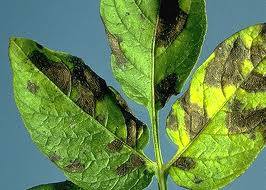
Hence when scouting for early blight be prudent to check the bottom older leaves as they happen to be the first to get affected.
As the disease progresses the affected areas appear dark brown-to-black with concentric rings around giving a ‘target’-like appearance within the dead tissue. The lesions grow bigger and join together to be one, but are kept in check by large leaf veins. This results in the exhibition of an angular appearance of the affected area.
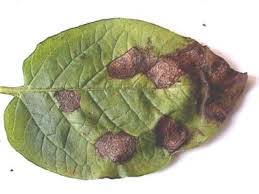 Depending with the physiology of the plant it is common to observe the affected area being surrounded by a chlorotic border of gradually dying tissues. Infection of the stems can also occur and appear as small dark lesions, but these do not cause significant damage to the integrity of the plants as compared to the leaves.
Depending with the physiology of the plant it is common to observe the affected area being surrounded by a chlorotic border of gradually dying tissues. Infection of the stems can also occur and appear as small dark lesions, but these do not cause significant damage to the integrity of the plants as compared to the leaves.
Tubers- affected areas on tubers tend to be dark, sunken and often bordered by a raised margin as seen in the picture below:
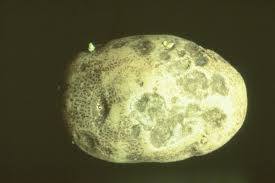
The underlying tissue assumes a leathery feel or rather corky texture. The appearance of the affected zones become an uninviting reddish to dark brown. Such tuber when stored for a considerable period of time shrivel and lose weight on the own.
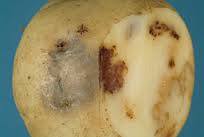
Differential Diagnosis
It is always important to exercise due care and diligence when scouting so that when cornered with an anomaly one is able to identify the disease in question accurately. This is important as it determines one’s reactions in addressing the problem. I mention this in light of the fact that there are several disease that are similar to early blight in their manifestations such that confusing them with early blight has always taken place. Such diseases are late blight, fusarium rot, botrytis and brown leaf spot. The primary differentiating sign between early blight and late blight is that the lesions under early blight are not able to transcend across the leaf veins (left photo) thus assume an angular appearance which is contrary to late blight as shown below.
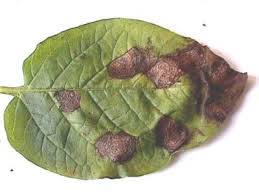
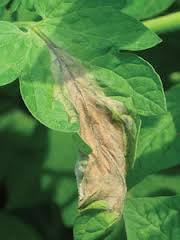
When looking at the tubers one should check for the distinctive raised margins around the affected part to discern that the causative is early blight as that feature is not found in the case of late blight. Still on tubers, of you happen to notice that the affected area is whitish-pink in appeal, rest assured that you have a case of Fusarium rot as early blight exhibits a brown colour.
How to Control Potato Early Blight
The first line of defence in terms of this disease is to ensure that you do not introduce it onto your farm. This is achieved through use of certified seed each time you plant potatoes. It also help to break the disease cycle by practising crop rotation with a crop of a different class such as a cereal. Always ensure that infected plant debris from the previous potato crop are destroyed prior to introduction of a new crop. Avoid using a field which is just close to one where there was a case of early blight as the infective material can lie dormant in the soil, harbouring requisite capacity to infect another crop the next season. In order to minimise losses it is advisable to plant cultivars that are resistant to early blight. Generally all early maturing cultivars are highly susceptible, so its wiser to settle for late maturing varieties which are famed for moderate early blight resistance. Ensure that your agronomic practices are such that your crop is not subjected to unnecessary stress as this tends to increase the susceptibility to early blight. Farmers should spray fungicides soon after the appearance of bloom and should continue to scout through their crop. Spray at the first sight of infection to curb the spread and damage. The need for due care during harvesting cannot be overemphasised given that most if not all of the tuber infection occurs during harvesting, particularly if the skin gets damaged. It remains my humble belief that if the above measures are judiciously taken on board by a potato grower one of the many problems chewing away your profits could be eliminated. Look out for the next instalment on yet another potato disease common in Zimbabwe.
For all questions and comments: email philemonburuzi@gmail.com. Responses will be provided within the shortest possible time.
http://www.agriuniverse.co.zw

